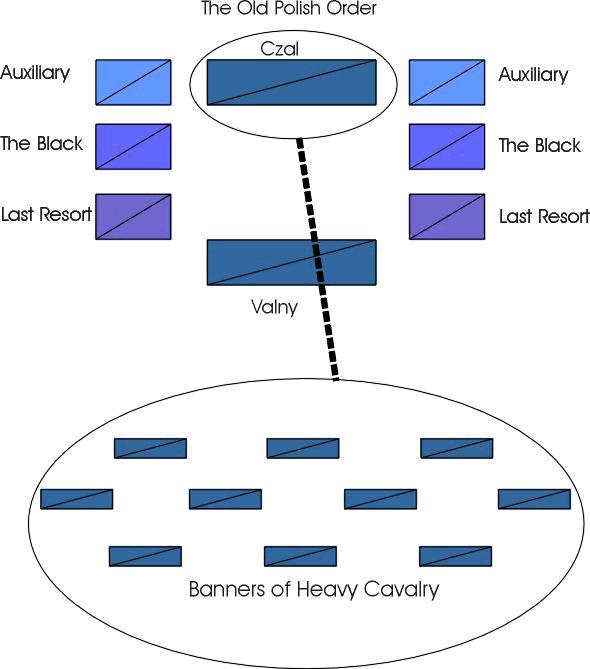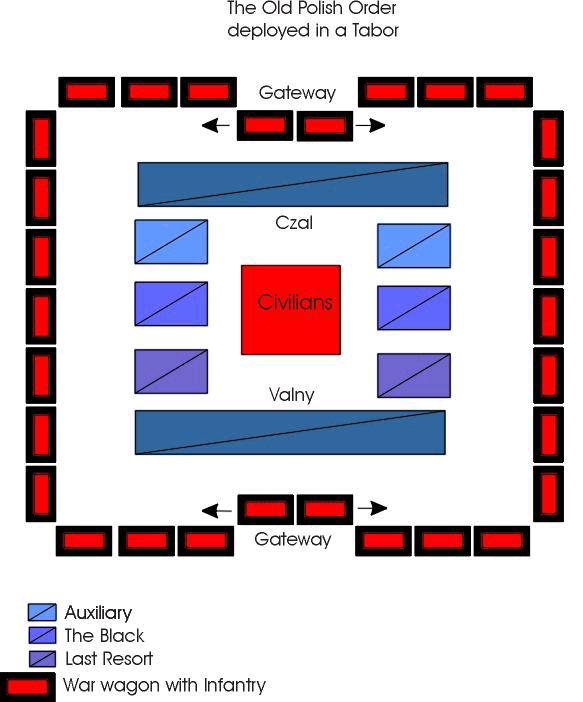Polish Battle Tactics
At the beginning of this period the Polish army deployed in lines. To the fore were one or more unbroken lines comprising the Cavalry and behind them a, usually much shorter, line of infantry. The basic tactic was a general charge, aimed at sweeping the enemy from the field! Although these tactics were little different to their Western neighbours, warfare against the Lithuanians, Russians and Tatars showed the vunerabilities of such an unresponsive formation. The manouverability and speed of her Eastern neighbours caused a shift in Polish tactical thinking and in the use of Light horse. The Polish adapted nomad deployments to suit their Knights. The standard formation was still a Centre of Knights and Strezlcy, now flanked by lighter horse deployed in a crescent shape. The centre comprised multiple lines of cavalry. However these were arrayed in a checkerboard fashion which allowed far greater flexibilty. Individual units could now react and alter direction far more easily than before. Infantry still deployed behind the cavalry,in the centre, their role was to assist if required.
The initial stage of the battle, much like the Mongol 'Grand Hunt', was for the light horse to sweep around the enemy flanks to envelop them or failing this delay them allowing the Polish centre to defeat the enemy centre. Lines of cavalry that had not engaged would redeploy and attack the enemy flanks, supported by their respective light horse wings. The propensity of Lithuanian light horse to engage enemy units in combat often led to their rout, admittedly this was occasionally a delibrate ploy, and was exploited by Polish Generals. The reserve lines of Cavalry were able to hit the victorous enemy wing/s while they reformed or were still pursuing. The battle of Tannenberg shows an example of how this Polish deployment was able to cope with new circumstances.
The key to Polish battle tactics of this era was flexibility. Adding to the tactics of the previous era there evolved a battle order which Spieralski records as being called the 'old' Polish Order by 16 Century writers. Spieralski postulated that this is because at the battle of Tannenberg these writers saw the beginnings of this formation in the flexibility of the Polish battle order. Diagram 1 shows the Old Polish order as described by Spieralski. The Czal and Valny were comprised of Heavy cavalry usually of equal size. The Valny comprised the veteran and heaviest cavalry and were used to deliver the decisive blow. The Auxiliary, Black and Last Resort (also known as the desperate) were comprised of light cavalry and were also usually of equal size. Its actual deployment depended on the battlefield and the opponent. Spieralski notes that the light horse wings often deployed either side of the Czal. In essence the old Polish order formed a basis for a multitude of tactical formations. Spieralski believed the battle of Lopushno (Lopuszno) in 1512 was the first use of the fully developed Polish Order. The battle of Orzsa in 1514 was apparantly a classic example of its use.
This period also saw a marked increase in the battlefield use of infantry. The battle of Swiecin saw the coordination between the cavalry and infantry achieve victory over the Teutonic Knights, whose own infantry played no part. Swiecin also saw the Poles deploy a Tabor fortress although it had little affect on the battle.
Adopted from the Hussites and frequently crewed by ex-hussite mercenaries the Tabor played an increasing role in the Polish battle tactics. The switch over to a smaller 'professional' mercenary army Meant there was usually a large desparity in numbers between the Polish army and that of their enemies. Like the Hussites the Polish used the Tabor to break their opponents attacks and then use their cavalry in a counter attack. The old polish order was also adapted for use within a Tabor. Diagram 2 shows the basic layout as described by Spieralski.
Diagram 1

Diagram 2


Copyright © 2002-2020 Matthew Haywood
All images and text, unless otherwise noted, may not be copied without my written permission.